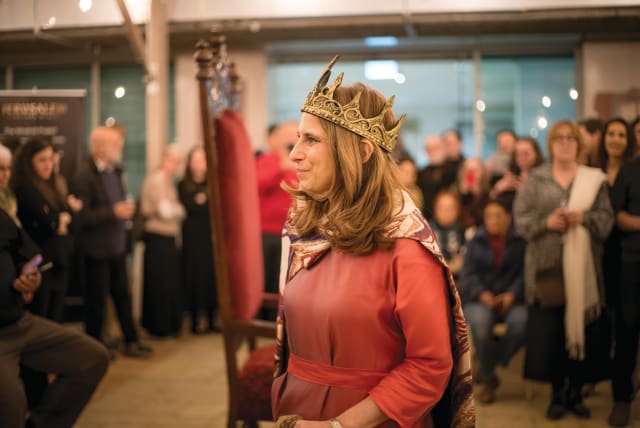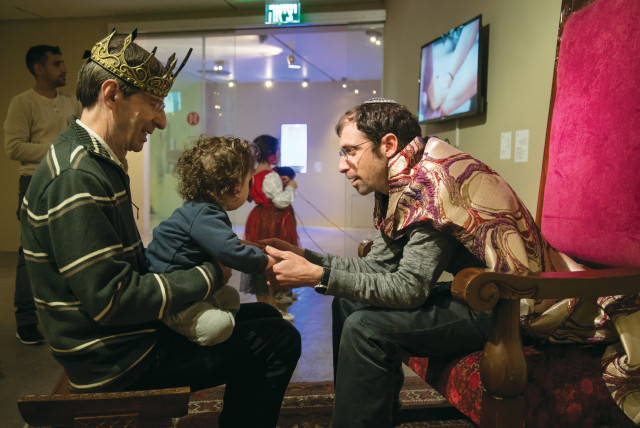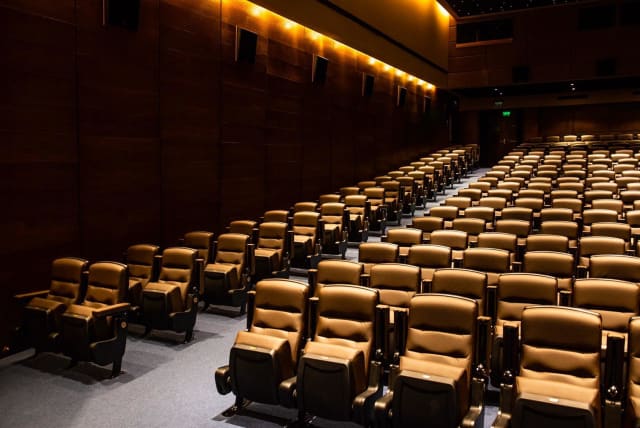
What is the connection between Queen Esther and the Ayelet Hashahar, the Doe of Dawn? Artist Alana Ruben Free could tell you, but she would rather show you via her newest installation, the fruit of decades of reflection: Esther’s Throne.
Born in Fredericton, Canada, Ruben Free describes the city as a “20th-century shtetl,” with its families of mainly Eastern European origin congregating in the sole synagogue, built by her great-grandfather and maintained until today by her uncle. Though ultimately earning a degree in business, she had been drawn since childhood to the arts. Not being accepted for a Rhodes Scholarship was “the best thing that ever happened to me, as I followed my heart and came to Israel.
“While studying Hebrew and Jewish studies at WUJS [World Union of Jewish Students] in Arad, I found my passion,” she said. She became a serious student of Judaism, and the seeds of her future aliyah were planted.
First, however, she married her university boyfriend and spent two decades in New York, a place where her artistic soul flourished. She studied many art forms, along with archetypal psychology, completed a master’s in Jewish history, authored several plays, co-created a documentary, and edited a poetry journal, all while raising a son.
But the Promised Land was calling. “In 2012, I wanted to do an MFA so that I could begin teaching writing. A friend suggested that I do it at Bar-Ilan University. So I did.”
The egg of presence
Some months after her official aliyah in 2014, Ruben Free was invited to be one of the curators and artists in a group show titled “Ima Iyla’a: The Art of Motherhood” for the 2015 Jerusalem Biennale. “Participating in a visual arts festival was a very big leap for me; I am much more aural. I immediately could hear a soundscape for my work. I wanted visitors to express powerful essential words that bond mothers with their children: presence, love, trust, respect, and appreciation.”
She had the idea of enclosing these words in a half-tonne metal egg, which would act as the sacred container. Because she was not a metal worker, she needed to find someone local to assist. Noticing his colorful metal designs displayed in a shop window, she approached well-known Israeli artist David Gerstein. They met for coffee, and he readily came on board, perfecting the design. The collaboration, Chavayah=Havayah (in English, Presence=Present), was a success. Participants sat together inside the egg and said to each other in turn: “I love you, I trust you, I respect you, I appreciate your presence in my life.” Some said that during that period of stabbings and terrorism, the egg felt like comfort and protection. (I myself sat in the egg with my friend, writer Nadia Jacobson. I still remember it as a remarkable few minutes of intimacy and encounter.)
Journey toward ‘Esther’s Throne’
Meanwhile, another artistic direction had been gestating within her. At a sacred-mask-making workshop with Marion Woodman in 2008, Ruben Free created a mask of a bearded man who, in her imagination, informed her, “My name is Mordechai.” Mystified, she put it away in a box, where it would remain for over a decade.
In 2016, while struggling with how to begin her thesis, she had an unexpected dream: “On the night of the American election, I was awakened from my sleep by a very powerful female energy bursting through a cloud… I turned on the light and started writing in the voice of Queen Esther.” This culminated in her thesis: a novella portraying Esther and Mordechai through the lens of the “sacred marriage,” a kind of salvatory partnership.
The next development occurred when a doctoral student and curator named Rachel Verliebter, impressed by Ruben Free’s unique teachings about Queen Esther, invited her to join a group exhibition planned for the 2023 Jerusalem Biennale. Each artist was asked to visually express the Doe of Dawn – a creature steeped in Jewish lore, a powerful female figure of fertility and redemption. The Zohar (III:249a-b) describes how, as the darkness of night is lifting, the doe is wracked by pangs of labor, but heaven compassionately sends a serpent to bite her and expedite the birth. The connection with Esther comes through Psalm 22 – the Psalm of the Doe of the Dawn – posited by the midrash as a prayer the queen utters as she approaches Ahasuerus’s throne, risking her life.
The vision manifests
As with the egg, Ruben Free again chose to set up an immersive, participatory installation as a sacred space, this time establishing a throne for Queen Esther in Jerusalem that would support visitors in expanding their hearts and imaginations. In the Jaffa flea market, she and Verliebter located a beautiful, large, hand-carved seat, bearing on top the ancient Rosetta symbol.
Additionally, after making a fundraising trailer, Ruben Free decided to make a short film, her first ever. “I possibly learned as much about filmmaking in the last nine months as a film school student does,” she remarked. She drafted a script under the mentorship of esteemed Israeli filmmaker Dan W. Wasserman. Faith, vision, and focus compensated for the lack of rehearsals as the artist and her crew launched into a film shoot in Jaffa on October 5. Aside from a few problems with the police, everything went off miraculously well.
The resulting footage was condensed into a nine-minute film titled "Esther Dresses in Divinity." Along with performative representations of the doe in labor, of Mordechai (the sacred mask having finally emerged from its box), and of Queen Esther wandering with her throne, the video shows the participatory paired ritual. Ruben Free chose to give the person seated on Esther’s throne the words of Ahasuerus: “Up to half the kingdom I will grant to you. Look inside your heart and tell me what you most desire for yourself and long for your people.” The person seated opposite then replies, articulating his or her desires. “Granted,” the queen responds, and both close their eyes and imagine those desires realized.
Onlookers are encouraged to participate spontaneously. The final cut includes two young boys, as well as a haredi grandmother and her posse of grandchildren. "Esther Dresses in Divinity," playing on loop in the exhibit, is layered and strangely touching and warrants more than one viewing.
Esther’s throne lives in Jerusalem
Queen Esther, exiled all these centuries in Persia, finally has her throne in Jerusalem and comforts her descendants in their time of need. The Esther’s Throne installation consists of three elements: film, throne, and live ritual. I participated in the latter, this time with the artist herself, and once more felt the sacred space and the opening of the heart she enables.
As I see it, Ruben Free’s talent is to take her profound dream/soul work and crystallize it into a brief, unique moment of transcendence, creating a better world – a ray of light sorely needed at this dark moment in our history.
“I think all Jews who seek to come home completely, body and soul, from exile owe a great debt to the spiritual example of Esther and Mordechai,” she said. “They taught me how to achieve victory through community, strategy, and courage.”
A timely message, indeed.
The Doe of Dawn exhibition at the Bible Lands Museum runs until May 30.
To experience the live ritual, contact alana.ruben at gmail.com or EsthersThrone on Instagram to schedule a time.
Other artists participating in the exhibition include Maya Zack; Yifat Bezalel; Sharon Barak; Sandra Valabregue; Iris Ahuva Pykovsky’ Giordana Musani; and Méïr Srebriansky. Curator: Rachel Verliebter.
| What: | ‘Esther’s Throne,’ in ‘Doe of Dawn’ exhibition |
| Who: | Alana Ruben Free |
| Where: | Bible Lands Museum |
| When: | Until May 30 |
| Why: | A unique video and performance art installation with a powerful message |








































































































